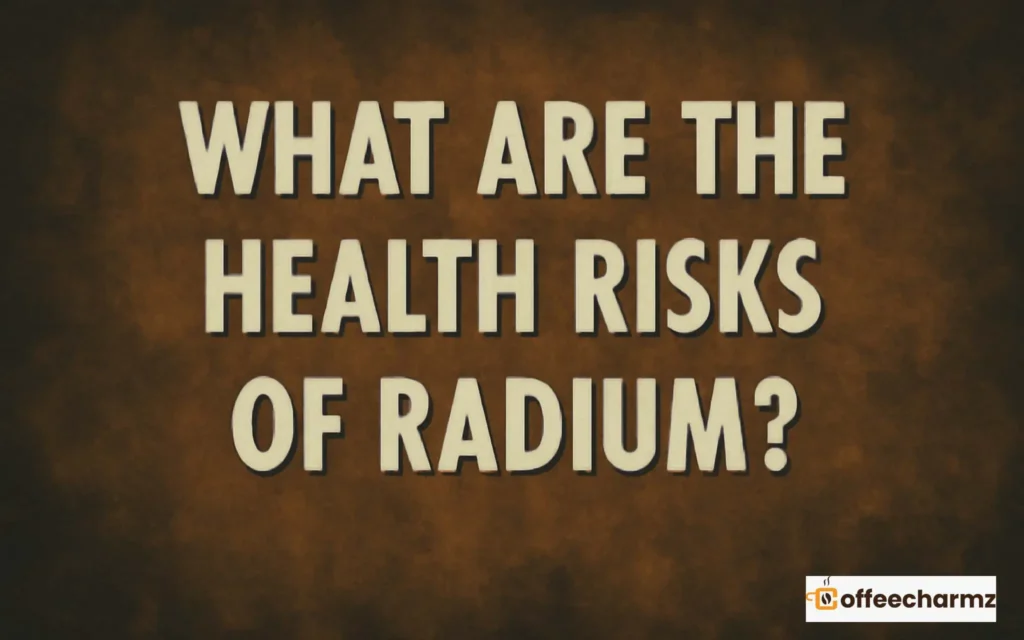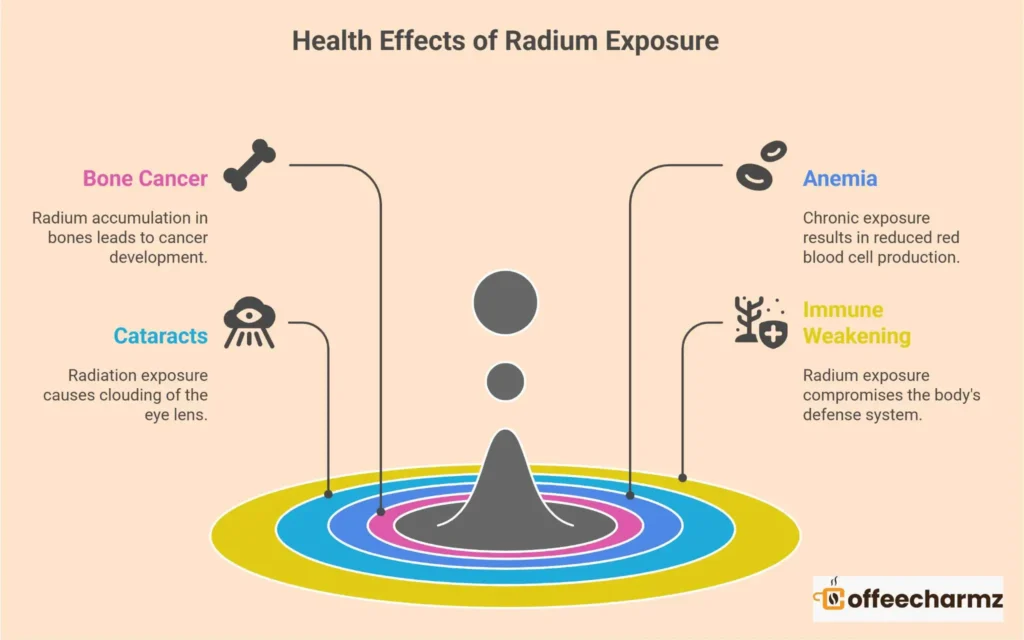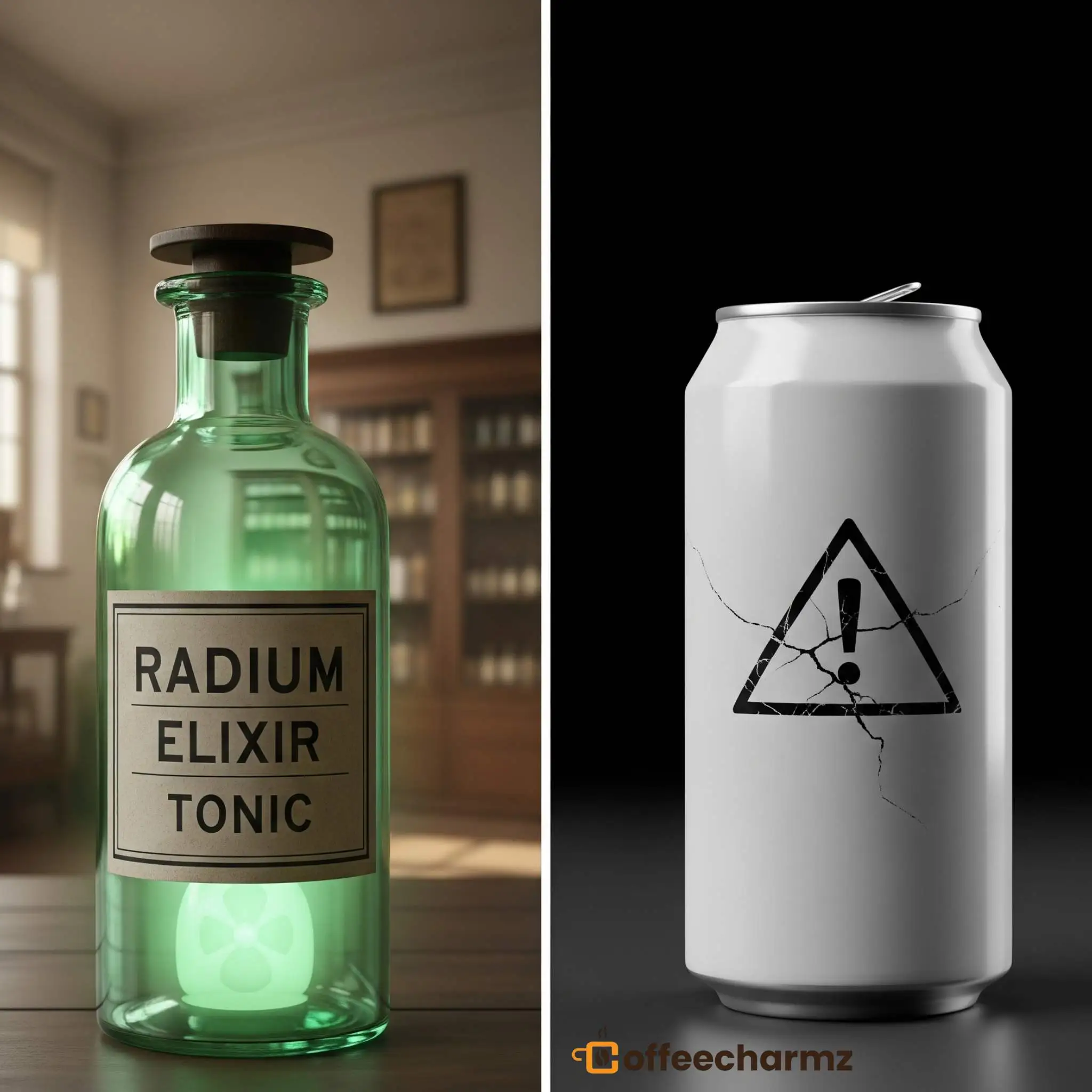Imagine consuming a drink that contains radium – a dangerous radioactive element. This became a reality in the early 1900s with Radithor, a controversial energy drink that gained attention for its dubious health claims.
While today’s energy drinks are far removed from such dangerous concoctions, the legacy of Radium-based drinks serves as a chilling reminder of the lengths to which people have gone in search of health remedies.
In this blog post, we’ll explore the rise and fall of Radithor, the dangerous effects of radium on the human body, and how the energy drink industry has evolved since then.
What Was Radium Energy Drink? The Story Behind Radithor
What Was Radithor?
Radithor was an energy drink that hit the market in 1918. It was marketed as a miracle elixir for boosting vitality and curing ailments, claiming that radium – a radioactive element – would have health benefits.
Radithor was created by William J.A. Bailey, a former Harvard student turned patent medicine peddler. The Radium Energy Drink was a simple concoction of distilled water infused with radium-226 and radium-228 isotopes.
Why Was It So Popular?
At the time, radium was viewed as a wonder substance, capable of rejuvenating the body and even treating conditions like arthritis, impotence, and more. It was included in a variety of products, including cosmetics and even toothpaste, under the belief that radioactivity could enhance health. Radithor capitalized on this craze, promising increased energy and a longer life.
Radium Energy Drink Facts!
- Radium Energy Drink is known for its bold flavor and energizing ingredients.
- Like most energy drinks, it contains a significant amount of caffeine to boost alertness.
- It often includes other stimulating compounds such as taurine and B vitamins.
- Energy drinks like Radium are popular for quick energy boosts, especially during demanding activities.
The Dark Side of Radithor: What Happened to Users?
Who Was Eben Byers?
The most famous victim of Radithor was Eben Byers, a wealthy industrialist and sportsman. Byers was a regular consumer of Radithor, drinking over 1,400 bottles in total. He was convinced by the claims that it would enhance his energy and vitality.
Tragically, his health deteriorated, and his body showed signs of severe radiation poisoning. Eben Byers, a well-known industrialist, tragically suffered severe radiation burns, ultimately losing his jaw. He passed away in 1932, marking a somber reminder of the harmful effects of consuming radioactive substances.
What Are the Health Risks of Radium?

Radium is a radioactive element that is chemically similar to calcium, which means it is absorbed by bones when ingested. Over time, radium’s radiation damages bone tissues, leading to bone cancer, anemia, and other serious health issues.
The long-term effects of radium exposure were not fully understood in the early 20th century, which contributed to the widespread popularity of products like Radithor.
How Did the Radium Craze End?
How Radithor Was Banned
Byers’ death brought widespread attention to the hazards associated with radium, prompting the government to intervene.
In 1931, the Federal Trade Commission (FTC) issued an order to stop the sale of Radithor, citing its harmful health effects and false health claims. Bailey, the creator of Radithor, was also ordered to cease his sales and advertisements.
The widespread controversy over Radithor led to a broader reassessment of products containing radioactive substances. This led to the establishment of stricter laws and regulations, resulting in the eventual prohibition of consumer products that contained radium.
How Radium Exposure Affects the Human Body

When radium is ingested, it can accumulate in the bones, causing severe damage over time. The radiation emitted by radium leads to bone cancer and other health complications. Chronic exposure can also result in anemia, cataracts, and increased susceptibility to infections due to the immune system’s weakening.
Modern Alternatives: How Today’s Energy Drinks Compare
The Evolution of Energy Drinks
While Radithor was once marketed as a “miracle cure,” modern energy drinks use scientifically proven ingredients like caffeine, taurine, and B-vitamins to provide quick energy boosts. These ingredients are commonly found in products like Red Bull, Monster, and other popular energy drinks,
but they are far safer than radioactive substances. Today’s energy drinks focus on providing an energy boost without the dangerous side effects of radium.
Are Modern Energy Drinks Safe?
Although today’s energy drinks do not contain radioactive elements, they can still pose health risks if consumed in excess. High doses of caffeine, sugar, and other stimulants can lead to anxiety, heart palpitations, and other health issues. It’s important for consumers to use these drinks responsibly and be aware of their caffeine content.
The Legacy of Radium: A Cautionary Tale
What Can We Learn from Radithor’s History?
The story of Radithor serves as a warning about the dangers of unregulated health products. It reminds us of the importance of scientific research and regulatory oversight when it comes to consumer goods. While radium was once hailed as a wonder element, its harmful effects became evident over time.
The Importance of Scientific Scrutiny
The Radithor incident underscores the need for careful scientific scrutiny before introducing new health products. With the rise of modern supplements and alternative health products, it’s essential for consumers to rely on evidence-based claims rather than marketing hype.
Key Takeaways
- Radithor was a radioactive tonic marketed as a remedy for enhancing energy and treating a range of health issues.
- The drink contained radium-226 and radium-228, which caused severe health issues like bone cancer and radiation poisoning.
- The tragic case of Eben Byers, who consumed Radithor regularly, led to the drink’s eventual ban in the 1930s.
- Modern energy drinks use safe ingredients like caffeine and B-vitamins to provide energy, though excessive consumption still carries risks.
Conclusion: The Impact of Radium and Modern Energy Drinks
The rise and fall of Radithor is a fascinating chapter in the history of health products, highlighting both the dangers of unchecked scientific claims and the evolution of modern energy drinks. While today’s energy drinks are far safer, the legacy of radium serves as a stark reminder of the importance of health safety regulations.
Always be mindful of what goes into the products you consume and make sure that claims are backed by solid scientific evidence.
Stay informed, stay safe, and use energy drinks responsibly.
Frequently Asked Questions
Q: Is radium safe to drink?
A: No, absolutely not. Ingesting radium is extremely dangerous and causes severe health issues, including cancer and death.
Q: Why was radium banned?
A: Radium was banned due to the horrific deaths of consumers like Eben Byers. This led to the 1938 Federal Food, Drug, and Cosmetic Act, mandating safety testing for products before sale.
Q: What is the most unhealthy energy drink in the world?
A: There isn’t one “most unhealthy.” The unhealthiest energy drinks contain extremely high caffeine, excessive sugar, and often use “proprietary blends” that obscure exact ingredient amounts, posing significant health risks.
Q: Is radium good for health?
A: No, radium is definitively not good for health. It is a radioactive element that damages cells and DNA, leading to severe illness and death.
Q: How long does radium stay in the body after ingestion?
A: Once ingested, radium integrates into bones and can remain in the body for decades. It continuously emits radiation, causing long-term damage.
Q: Are there any legitimate medical uses for radioactive elements today?
A: Yes, but under strict control. Specific radioactive isotopes are used in diagnostic imaging (e.g., PET scans) and targeted radiation therapy for cancer, not as general health tonics.
Q: What are some common side effects of modern energy drinks if consumed excessively?
A: Excessive consumption can lead to heart palpitations, anxiety, insomnia, headaches, and in severe cases, seizures or cardiac arrest.

